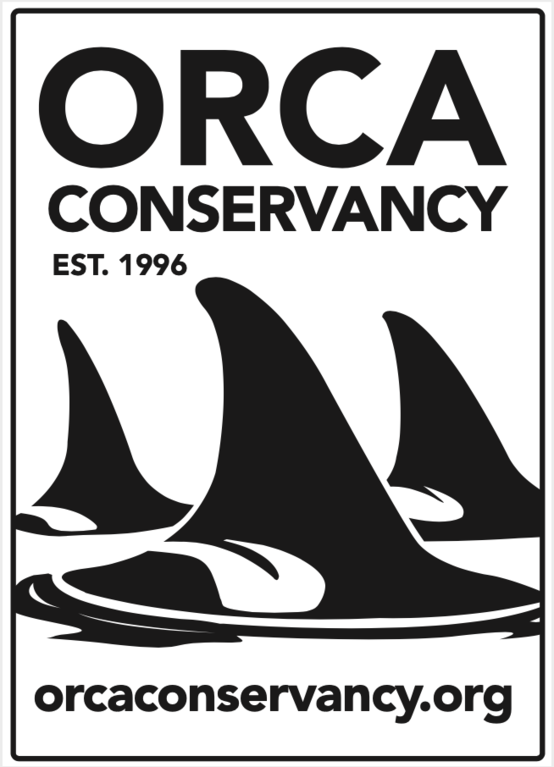May 7, 2024: T Parties | Point Roberts, WA
Date: May 7, 2024
Location: Point Roberts, WA
Weather: Partly sunny, 55 degrees Fahrenheit, with 8mph winds from S
Tide: Flood
Pods/Individuals: T18, T19C, T65, T63, T71Bs, T86A1, T86A3, T86A3A, T124As, T124Ds, T124A1, & T124A1A (presumed)
Total whale count: 15~
Behaviors: Traveling
Boat Count: 5 (4 whale watch boats, 1 private boat)
Observer: Tamara Kelley
T63 Chainsaw and T19C Spouter (Photo by Tamara Kelley)
I took my first boat trip of the season and went out with Outer Island Excursions, sailing out of Skyline Marina in Anacortes, WA. All of the orca reports I had seen were for multiple groups down in South Puget Sound, which would be too far for this tour to access. There were no confirmed reports of orcas within our range, but was hopeful that throughout the day we would find some.
We sailed out of the marina and went north into Rosario Strait. We did a short pass around Lummi Rocks to the west of Lummi Island in search of wildlife such as seals or sea lions hauled out on the rocks. We found a couple of harbor seals thermoregulating and viewed them for a couple of minutes before continuing our trip north.
At this point there still hadn’t been any confirmed orca sightings, so when in route, my friend Silver and myself scanned with our binoculars from the boat in hopes of finding something. Eventually, one of the naturalists on board spotted a humpback whale so we went in search to check it out. Unfortunately, the humpback went on a long dive, and after 14 minutes of waiting, the crew decided to move on to look for orcas. At this point, it was looking like we might get skunked, but luckily for us, an unconfirmed report had come in, so we set off in search of these animals.
While searching, both Silver and I saw some distant exhales as the boat stopped, so we along with the crew began scanning this area. After several minutes, the captain spotted a group of orcas, and we made our way to them. Not knowing who these whales were, I was very surprised and excited when I looked threw the viewfinder of my camera and noticed a very distinct dorsal dorsal fin with two large notches, T63 Chainsaw.
T63 Chainsaw was traveling with his mother, T65 Whidbey II as well as two other whales T18 Esperanza and her grandson T19C Cooper. The group of 4 was an impressive sight, and they would surface together in a synchronized group. The whales began traveling south, and as we followed them eventually the two females in the group broke away from the two males, traveling southeast closer to shore. The two males stayed further from shore, traveling close together. We remained with the two males, and on a few different occasions after they would go on a deep dive, they surfaced fairly close to the boat, within 300 yards. Per Be Whale Wise regulations, the captain turned off the boat motors for the safety of the whales and to allow them to pass, and this gave us a few opportunities to be able to hear their exhales and get some stunning looks.
After viewing this group for a while, it was time for us to make our way back to port. Shortly after we set en route, the crew was notified of a second group that was on the way, so we stopped for some very quick looks. The second group we saw was a mix of individuals from the T71Bs, T86As, T124As, and the T124Ds. Because this group was so mixed and matched with various individuals from multiple matrilines, it made IDs quite tricky. Later after going through photos and video, I realized that T124A1 Bonapartes was also present. She is famous for being a lone female but recently was sighted with a new calf, T124A1A. There were 3 total young calves in my videos and photos, two of which I can confirm the IDs. I cannot fully confirm the third calf, since this calf surfaced alone away from mom, and there aren’t sufficient eye patch shots for me to ID this calf, though I am presuming it is T124A1A. Worth noting, there was some concern about the health of T124A1A, as it was looking quite thin for a while, luckily more photo updates have shown that this calf is starting to fill out.
I was pretty excited because the T86As are a group that was new to me, and I got to see the newest calf T86A3A, which my colleague Kendra had just seen and photographed the week prior. In fact, she had almost the same group with the 71Bs, 86As, and some of the 124s, so it was exciting to follow their travels from Vancouver Island down into the Salish Sea. In the following few days, this group continued South in the Salish Sea and was spotted in South Puget Sound.
Another interesting note is that in the previous year, I had seen T63 Chainsaw and his mother in Puget Sound, and the two of them had also been traveling with members of the T71Bs and T124As. There are no known maternal relations between T65 and T63 with these matrilines, but they have been observed with these family groups multiple times indicating a social association. I always find the social dynamics of the transient/Bigg’s killer whales so fascinating and love to see who travels with whom.
Learn more about the T18s, T65s, T124As, T124Ds as well as other matrilines on our Transient page.
Download the free Department of FIsheries Canada Bigg’s Transients ID guide





















